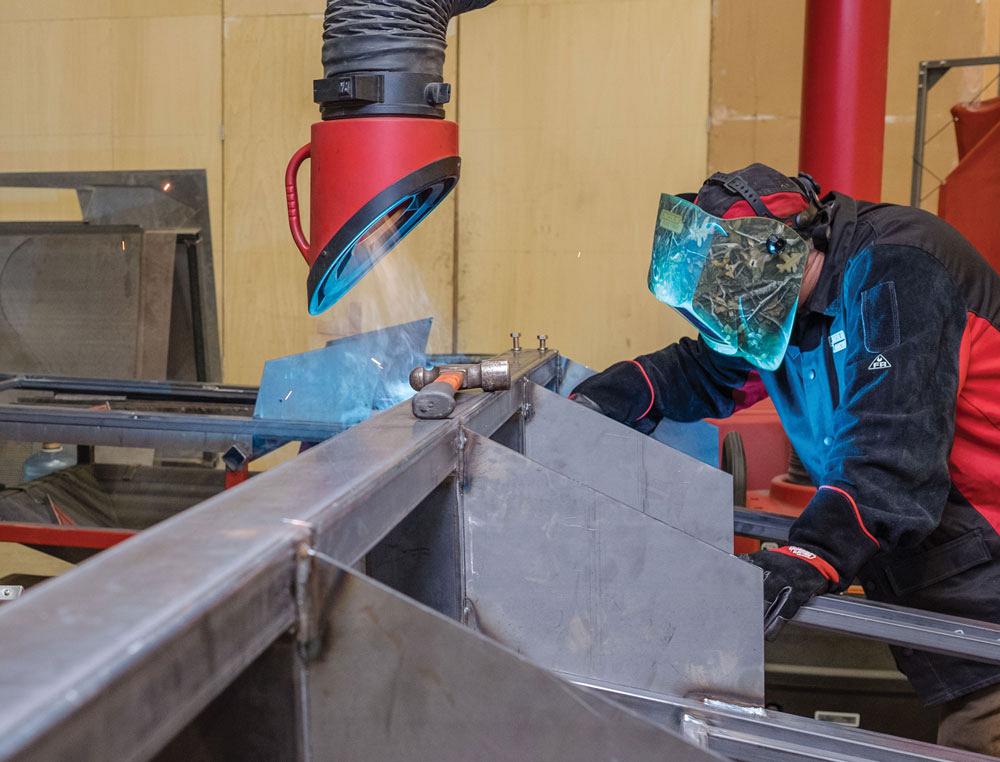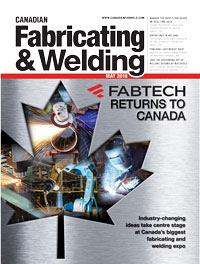Editor
- FMA
- The Fabricator
- FABTECH
- Canadian Metalworking
Adventures in welding
John Spridgeon shows where a passion for the trade can take you – the stars and beyond
- By Rob Colman
- May 15, 2018
- Article
- Welding
Few of us will ever have the opportunity to walk on a spaceship, never mind build one. That makes John Spridgeon a rarity. Granted, the spaceships his team has welded aren’t likely to blast off anytime soon except in your living room, but that doesn’t take away from what he’s done.
Spridgeon was lead fabricator on the first season of the newest “Star Trek” series, “Star Trek Discovery.” What’s most remarkable is that this particular job isn’t necessarily the coolest he’s ever had. His career is an example of where welding skills can take someone – to the stars and beyond. His has been a winding path, but welding always ended up taking centre stage, on stage and off.
Learning by Mistakes
Spridgeon likes to joke that he had “the attention span of a hockey puck” in school. In fact, he was about to drop out of high school when he was given the opportunity to join a program in which he worked on one skill a week – it might be math one week, then carpentry, then autobody work, then welding.
“I treated each week like a job,” he said. “I started at 9, left at 3, took my breaks when I was supposed to. It was great. Ever since then all I’ve done is learn, absorb, absorb, absorb stuff. There wasn’t anything that anyone did where I wasn’t asking, ‘What’s that?’ I always want to be learning.”
His career has been similarly diverse. In fact, after an hour conversation I can’t honestly say that any story I could write could explain his career in a straight line, but I’ll do my best.
When Spridgeon started a career in welding at 16, it was with a small mobile welding company. From there he moved from one company to another, developing a diverse range of skills.
“One of the most valuable early jobs I had was working for a steel company that built factory monorails,” he said. “I went into that job to replace someone who shouldn’t have been a welder. I spent the first year in that job basically learning structural steel welding by seeing other people’s mistakes and learning how to fix them.”
At the same time, he was watching what others were doing on construction sites, and in the process decided to become a steelworker. And in time he would become a crane operator, because, as he said, “that looked even cooler.”
That’s Entertainment

When asked what skills someone needs to bring to the table on set as a welder/ fabricator, Spridgeon says bring your sensibility: “Bring your brain, be the first at the table to find out what the plans are, and get your certifications. Don’t just stop at your welding ticket.”
Spridgeon has always been one for adventures, so when a friend in the entertainment industry said there was a call for riggers for rock concerts, he jumped all over the opportunity. His first concert was a Ted Nugent show at Exhibition Stadium in Toronto, after which he went on to work numerous tours all around the world with the likes of Meat Loaf and The Rolling Stones. In the process he was involved in welding special designs for animatronic sets, rigging 3-D trusses that rotate around the top of the stage, and building mortars for the pyrotechnics at shows.
“When you’re a rigger/fabricator, you’re welding things like anchor plates and you’re building protections for the corners of sets. And you end up using all the skills you’ve got – TIG, MIG, arc welding, gas, you name it.”
Spridgeon ended up rigging for Cirque du Soleil for several years, and the skills he’d learned working structural jobs, crane operation, grip work, and all his other welding skills came into play. He considers himself a contractor with multiple skill sets. But that broad set of skills becomes critical in his welding work.
“When you’re a welder on jobs like this, you’re not just a welder, you’re a fabricator,” said Spridgeon. “You really have to understand how everything fits together. On ‘Star Trek,’ all the ships we built were 12 feet off the ground. All the railings and flooring in them were steel. As the lead on a production like that you have to understand how that is going to be built to remain stable and safe.”
Talent Shortage
“Star Trek” is only one of many productions Spridgeon has had a hand in. Most recently he worked on a set that has to collapse in the scene of a movie and a bus that slides sideways on a track. On these two recent jobs he has strictly been a welder rather than the team leader, but as he sees it, every job of this kind is a team effort.
“When I’m leading a job, I try to teach the new welders by throwing them into the breach and giving them projects to work on on their own. And if I need to I show them how. We need more welders/fabricators. There’s a real lack out there.”
This shortage of new talent really concerns Spridgeon.
“In 15 years from now, who’s going to do the welding? People think that it’s a dirty job, the noise is bad, and that field guys have to work outside in the dead of winter. If I called the union and asked for one welder tomorrow, I’d be unlikely to get one. And that’s bad. I just went in to get recertified for my plate and pipe work, and all the guys there with me were working, there was no new blood. The thing about film production work is that in Toronto, Montreal, and Vancouver, there is a lot of work out there.”
When asked what skills someone needs to bring to the table on set as a welder/fabricator, Spridgeon says bring your sensibility: “Bring your brain, be the first at the table to find out what the plans are, and get your certifications. Don’t just stop at your welding ticket. Get your forklift, telehandler, working at heights training, and your first aid. Nothing gets you hired faster than your tickets.
“If you’re going to learn how to weld, make sure you really learn,” he continued. “Learn how to fabricate. Take the job they’re telling you to build and really think through how it needs to be built, what pieces go where, and, ultimately, how you’re going to move it from point A to point B. Thinking like a crane operator and a steelworker comes in handy sometimes.”
Spridgeon said GTAW and GMAW are big in a lot of jobs that he performs, but it’s important to understand all the different types of welds you might be called upon to do.
Mobility Benefits
Like most welders, Spridgeon is a one-brand guy.
“I’m a Lincoln Electric guy and have been for years. I have worked with the red-faced SAE-300 engine-driven welders, the Vantage 300 engine-driven welders. Those machines are just mind-blowing.” Recently, he used the Vantage 300 for the first time on a movie production. “I turned it on and it was so quiet,” he recalled.
Mobility is important in a lot of the welding Spridgeon performs on sets, though. If you’re going to work the exterior or interior of a spaceship, you need to be mobile. In most cases, that leads him to the Lincoln 210 MP (multi-process) welder. “It uses a gas-shielded flux core wire, shielded with CO2, runs at 70,000 PSI, and I can carry it around in one hand.” In the shop he also uses the Aspect 375, which is an AC/DC inverter GTAW unit, and a Power MIG® 256 GMAW unit.
Like anyone in the trades, Spridgeon’s greatest joy is in seeing the finished product of his labours.
“An ironworker bangs buildings together,” he said. “At the end of the job he can say, ‘I was part of the crew that did that; it’ll always be there.’ Well, we built spaceships. How many welders can say they’ve done that?”
Editor Robert Colman can be reached at rcolman@canadianfabweld.com.
About the Author

Rob Colman
1154 Warden Avenue
Toronto, M1R 0A1 Canada
905-235-0471
Robert Colman has worked as a writer and editor for more than 25 years, covering the needs of a variety of trades. He has been dedicated to the metalworking industry for the past 13 years, serving as editor for Metalworking Production & Purchasing (MP&P) and, since January 2016, the editor of Canadian Fabricating & Welding. He graduated with a B.A. degree from McGill University and a Master’s degree from UBC.
subscribe now


Keep up to date with the latest news, events, and technology for all things metal from our pair of monthly magazines written specifically for Canadian manufacturers!
Start Your Free Subscription- Trending Articles
Portable system becomes hot tech in heat treatment

Cidan Machinery Metal Expo 2024 to be held in Georgia May 1-2

CWB Group launches full-cycle assessment and training program

Achieving success with mechanized plasma cutting

3D laser tube cutting system available in 3, 4, or 5 kW

- Industry Events
MME Winnipeg
- April 30, 2024
- Winnipeg, ON Canada
CTMA Economic Uncertainty: Helping You Navigate Windsor Seminar
- April 30, 2024
- Windsor, ON Canada
CTMA Economic Uncertainty: Helping You Navigate Kitchener Seminar
- May 2, 2024
- Kitchener, ON Canada
Automate 2024
- May 6 - 9, 2024
- Chicago, IL
ANCA Open House
- May 7 - 8, 2024
- Wixom, MI
















